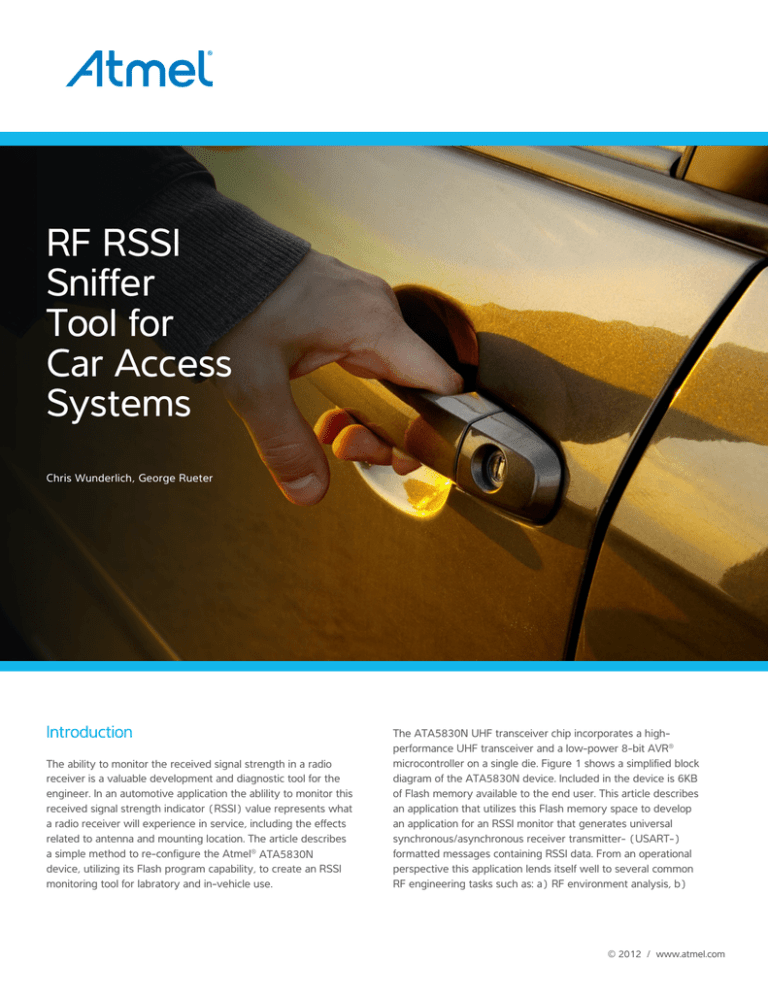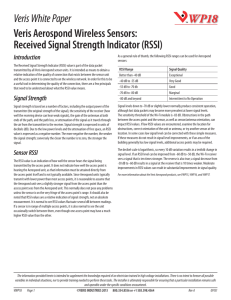
RF RSSI
Sniffer
Tool for
Car Access
Systems
Chris Wunderlich, George Rueter
Introduction
The ability to monitor the received signal strength in a radio
receiver is a valuable development and diagnostic tool for the
engineer. In an automotive application the ablility to monitor this
received signal strength indicator (RSSI) value represents what
a radio receiver will experience in service, including the effects
related to antenna and mounting location. The article describes
a simple method to re-configure the Atmel® ATA5830N
device, utilizing its Flash program capability, to create an RSSI
monitoring tool for labratory and in-vehicle use.
The ATA5830N UHF transceiver chip incorporates a highperformance UHF transceiver and a low-power 8-bit AVR®
microcontroller on a single die. Figure 1 shows a simplified block
diagram of the ATA5830N device. Included in the device is 6KB
of Flash memory available to the end user. This article describes
an application that utilizes this Flash memory space to develop
an application for an RSSI monitor that generates universal
synchronous/asynchronous receiver transmitter- (USART-)
formatted messages containing RSSI data. From an operational
perspective this application lends itself well to several common
RF engineering tasks such as: a) RF environment analysis, b)
© 2012 / www.atmel.com
performance tuning of the receiver section, c) RF component
selection and d) antenna performance evaluation.
AVCC VS DVCC
SRC, FRC
Oscillators
AVR CPU
Rx DSP
EEPROM
ROM
Flash
Tx DSP
SRAM
RF
Frontend
RFOUT
RSSI Measurement Details
Supply
Reset
AVR
Perepherals
RFIN
DATA BUS
XTO
XTAL
Port B (8)
Port C (6)
PB [0 to 7]
(SPI)
PC [0 to 5]
Figure 1. ATA5830N Block Diagram
Flash-based RSSI Application
RSSI data is a critical radio reception metric that reflects the
level of RF signal energy at a given frequency channel and is
useful in evaluating an RF environment. The Flash memory
application uses the internal RSSI measuring function of the
chip and communicates this value using a general-purpose
I/O pin using standard USART communication protocol timing.
This article describes how a Flash program application is
implemented and demonstrates the flexibility of the internal
AVR controller. The Flash application provides a small flexible
RSSI measurement tool that can be easily and quickly
configured to operate across a wide range of frequencies,
providing a simple way to measure RSSI.
The software for this demo was developed using the
ATAK51002-V1 evaluation kit. The application operates with
no external inputs required other than 5V DC power and
the RF signal source. The desired radio parameters, such as
frequency and intermediate frequency bandwidth (IFBW), are
programmed into the part using the EEPROM configuration file.
The user selects these values by using an Excel spreadsheet
tool that automatically generates the EEPROM file. Once these
values are programmed into the EEPROM, the application
of power will automatically initiate the self-configuration and
execution of the Flash application program. It begins measuring
and outputting the 8-bit RSSI data values on pin 17 (PC3)
of the device. USART communication parameters are 38400
Baud, 8 data bits, 1 start bit and no parity bit (38400, 8-1-N).
Each data byte output requires about 260μs to transmit and
occurs about every 50ms. The output data is at logic value
Automotive Compilation Vol. 9
voltage levels (about 0V to 5V) and, while not compliant with
RS-232 standards, most PCs have no problem in receiving and
displaying this data stream using a terminal program.
Received signal strength indicator (RSSI) is a measurement of
the power present in a received radio signal. In the ATA5830N
chip, this function is built into the receiver’s digital signal
processing (Rx DSP) section and occurs completely in the
digital signal domain, allowing for high relative and absolute
RSSI accuracy.
In this application, RSSI values are returned as 8-bit values and
the signal power at the matched 50Ω antenna input can be
calculated in dBm as:
RF Power In (dBm) = RSSI/2 – 155 (154 in 868-928MHz
band)
The ATA5830N datasheet notes the following RSSI
measurement specifications:
•
•
•
Absolute RSSI accuracy +/- 5.5dBm
Relative RSSI accuracy +/- 1dB
RSSI resolution 0.5dB
The typical RSSI range is a function of the IFBW selected:
•
•
•
•
IFBW = 25kHz >>> RSSI = -115dBm to -25dBm
IFBW = 80kHz >>> RSSI = -110dBm to -25dBm
IFBW = 165kHz >>> RSSI = -105dBm to -25dBm
IFBW = 366kHz >>> RSSI = -100dBm to -25dBm
Software Operational Flow
On power-up and after the hardware-generated power-on
reset is complete, the AVR controller will execute its main()
function in ROM, where the EEPROM configuration settings
are loaded and checked. This EEPROM configuration defines
all operational parameters of the device, including that a Flash
application program is present. When this EEPROM setting is
encountered, the application flow jumps to the Flash main(),
and the application flow begins. The Flash main() function can
be very simple since the ROM software functions will perform
most of the work. In this application, the Flash program function
loops indefinitely, first requesting ROM-code-based RSSI
measurements and then calling Flash code functions that format
and output the data. The following is the Flash program loop
that drives this application:
for(;;){
_WDR;
ATA_makeGlobalSystemFlags(); RDCR |= (1 << RQSS);
rssi=RSSI;
if (rssicnt==100){
RSSI_flash();
RSSI_TransmitValue(rssi);
while ((T4CR & (1<<T4ENA))); PORTC &= ~(1<<PORTC3);
TMCR = (TMCR & 0xF8) | SSI_PC3_OUTPUT; ATA_timer4Close();
}
rssicnt++;
}
Operation and Use
Hardware Platform
The ATA5830N can be used in several frequency bands:
310MHz to 318MHz, 418MHz to 477MHz and 836MHz to
928MHz, operating from a single crystal. The highly integrated
radio architecture is optimized for minimal external part count.
See Figure 2 for the schematic of a low-band Flash-based
application such as the one described in this article.
Setup
The only required external signals are a +5V power supply
and the RF signal input. The reference design included in the
ATAK51002-V1 evaluation kit consumes about 9mA when
running this application, which is sufficiently low to enable
battery-powered use. Once the reference design is powered
up, the ATA5830N device must be awakened by momentarily
connecting any of the “npwron" pins (15, 16, 17, 18, 19 and
29) to ground or the “pwron” pin to +5V. After the part is
awake and active, no other input is required and the RSSI data
will be available at PC3 pin 17.
RF Considerations
In addition to the EEPROM configuration settings, the hardware
in the RF path must be optimized or “matched” to the specific
frequency being used. The default configuration frequency
// ROM code check and execution of mode changes
// Register bit set to request RSSI measurement
// Store the RSSI register value in SRAM variable
//Every 100th reading output data to FLASH program (~50mS)
// FLASH program to initialize required timers
// FLASH program to format and output data
// Wait for data transmission to complete
// Set output port value
// Set the modulator MUX to output at PORTC
// Close the timer used by the FLASH functions
// increment counter
for the ATAK51002-V1 evaluation kit is 433.9MHz, so the
application kit hardware is shipped with this hardware installed.
If another frequency is selected, the matching component
values in the RF signal path need to be changed.
The ATA5830N device includes two separate LNA inputs,
one for low-band (315MHz and 433MHz) and one for highband (869MHz to 902MHz) operation. These LNA inputs are
provided since the chip is capable of multi-band operation and
these separate ports provide optimum performance matching
for each frequency range. The hardware configuration as
shipped utilizes the low-band input port. The hardware must be
modified accordingly to measure a high-band frequency.
A list of component values for several common radio frequency
bands is available upon request and included in the evaluation
kit. Installation of the corresponding hardware component
values is required for optimal performance at the desired
frequency.
PC Connection
Data is output at pin 17 (PC3), which can be accessed at one
of the I/O pins on the hardware evaluation board. This signal
can be connected directly to pin 2 of a PC-connected RS-232
port. While the voltage level is not compliant with RS-232
standards, most PCs will successfully receive this data. The
data can then be displayed using a terminal emulation program
such as “Realterm”, available at no cost at http://realterm.
sourceforge.net/.
© 2012 / www.atmel.com
VS
VS
8
PB3
PB4
PB5
PB6
PB7
PB1
SPDT_RX
PB0
Atmel
ATA5830
SPDT_ANT
ANT_TUNE
DGND
DVCC
SPDT_TX
PC5
RF_OUT
PC4
VS_PA
PC3
TEST
_EN
9
10
11
12
13
14 15
24
23
22
21
20
19
18
17
PC2
7
25
RFIN_HB
PC1
6
26
PB2
PC0
5
28 27
VS
4
RFIN_LB
29
AVCC
3
ATEST TEST
_IO1 _IO2
XTAL2
2
30
XTAL1
1
31
AGND
32
16
VS
VS = 3V
Figure 2. ATA5830N Flash Application Schematic
Data Collected
Figure 3 shows sample RSSI data collected using the described
Flash application with the ATA5830N chip configured to operate
at a center frequency of 314.9MHz with an IFBW of 165kHz.
ATA5830N RSSI Response
-20
RSSI Value Output
-30
Perhaps the most useful application for this tool is the
optimization of external components for an automotive car
access system using the ATA5780N or ATA5830N device.
Traditional fine-tuning of a receiver requires a method to
extract received data or RSSI, and is typically done with an
external microcontroller. Using this application, the external
microcontroller and its programming can be eliminated—all that
is needed is a PC.
-40
-50
-60
-70
-80
-90
-100
-110
-120
-120 -110 -100 -90
-80
-70
-60
-50
-40
-30
-20
-10
RF Power Input
Figure 3. Sample Data Collected Using Flash Application
Summary and Results
This article highlights the capability and flexibility of the
ATA5830N radio transceiver. By generating a program that runs
in the Flash memory space, and leveraging the available ROM-
Automotive Compilation Vol. 9
based functions, end users can customize the chip for their
individual needs. The described application, for example, reports
measured RSSI values every 50ms using standard USART
timing. This tool would be useful in RF environment analysis
such as choosing an operating band or frequency. While not
quite as easy to program as a commercial spectrum analyzer,
the tool does provide a means to test the RF energy content of
a specific frequency and measurement bandwidth.
External References
The software and documentation, incl. an application note with
even greater detail for this application, is available by contacting
automotive@atmel.com.
The Flash software program was generated using Atmel Studio
6, IAR Embedded Workbench for AVR and JTAGICE mkII.
Atmel Corporation
1600 Technology Drive, San Jose, CA 95110 USA
T: (+1)(408) 441-0311
F: (+1)(408) 487-2600
|
www.atmel.com
© 2012 Atmel Corporation. All rights reserved. / Rev.: Article-AC9-RF-RSSI-Sniffer-Tool_V2_042015
Atmel®, Atmel logo and combinations thereof, and others are registered trademarks or trademarks of Atmel Corporation or its subsidiaries.
Other terms and product names may be trademarks of others.
Disclaimer: The information in this document is provided in connection with Atmel products. No license, express or implied, by estoppel or otherwise, to any intellectual property right is granted by this document or in connection with the sale of Atmel
products. EXCEPT AS SET FORTH IN THE ATMEL TERMS AND CONDITIONS OF SALES LOCATED ON THE ATMEL WEBSITE, ATMEL ASSUMES NO LIABILITY WHATSOEVER AND DISCLAIMS ANY EXPRESS, IMPLIED OR STATUTORY WARRANTY
RELATING TO ITS PRODUCTS INCLUDING, BUT NOT LIMITED TO, THE IMPLIED WARRANTY OF MERCHANTABILITY, FITNESS FOR A PARTICULAR PURPOSE, OR NON-INFRINGEMENT. IN NO EVENT SHALL ATMEL BE LIABLE FOR ANY DIRECT,
INDIRECT, CONSEQUENTIAL, PUNITIVE, SPECIAL OR INCIDENTAL DAMAGES (INCLUDING, WITHOUT LIMITATION, DAMAGES FOR LOSS AND PROFITS, BUSINESS INTERRUPTION, OR LOSS OF INFORMATION) ARISING OUT OF THE USE OR
INABILITY TO USE THIS DOCUMENT, EVEN IF ATMEL HAS BEEN ADVISED OF THE POSSIBILITY OF SUCH DAMAGES. Atmel makes no representations or warranties with respect to the accuracy or completeness of the contents of this document and
reserves the right to make changes to specifications and products descriptions at any time without notice. Atmel does not make any commitment to update the information contained herein. Unless specifically provided otherwise, Atmel products are not
suitable for, and shall not be used in, automotive applications. Atmel products are not intended, authorized, or warranted for use as components in applications intended to support or sustain life.


